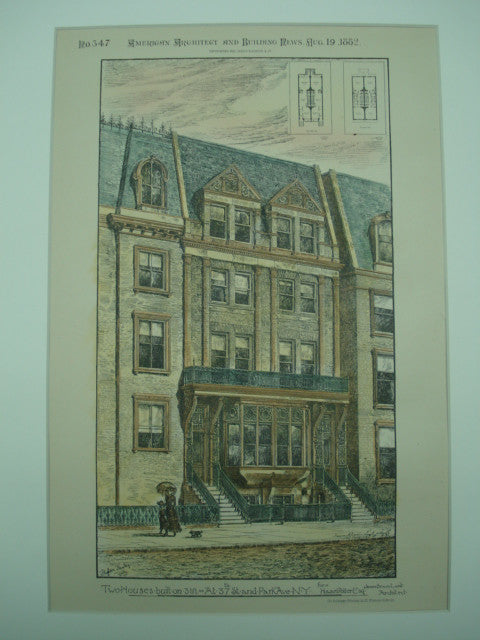News
The Nation Shakes in 1886 August 26 2015
This is the eleventh installment in our series of posts comparing significant events from a year in United States history with a few of our unique architectural plans from the same period. 1886, the topic of this installment, subsequently marks the eleventh year of the American Architect and Building News' existence.
Click on the pictures to find the plans below in our store!
In 1886 a general strike began among the workers of the United States to fight for better working rights within the nation. It culminated with the Haymarket affair at Haymarket Square in Chicago, Illinois. Originally a peaceful rally in support of those striking, the situation took a turn for the worse when someone threw a bomb towards the police line watching over the protests. Seven police officers and four citizens were ultimately killed in the resulting chaos. This Store Building on State St. for Ben Bagaman would soon be built near to the square, and its workers would soon be rewarded with the eight-hour workday fought for by their fellow workers. It was designed by Addison & Fielder.
On August 31 of 1886, an earthquake of magnitude 7.6 hit the coast of southeastern South Carolina, right near Charleston. Over 2,000 buildings in the area were destroyed and 60 lives were lost. Before this earthquake, almost no seismic activity was recorded in the history of the area, though it sits right near an active tectonic region. The St. James' Goosecreek Church in Charleston, South Carolina, designed by an unknown architect, likely was built after the earthquake hit the region. However, one would hope that all new buildings built in the area after the event would be reinforced to prevent such massive damage in the future.
Electricity Begins and Poetry Ends in 1882 August 17 2015
This is the seventh installment in our series of posts comparing significant events from a year in United States history with a few of our unique architectural plans from the same period. 1882, the topic of this installment, subsequently marks the seventh year of the American Architect and Building News' existence.
Click on the pictures to find the plans below in our store!
Thomas Edison continued to shape the nation's history in 1882. To add to his list of ever-growing achievements, he established the world's first commercial electric power plant, giving electricity to an entire square mile of lower Manhattan. These two houses, at 37th Street and Park Avenue for Howard Potter, might have not been in that original lighted area, but were sure to soon feel the full effects of Edison's genius. They were designed by the master of the Beaux-Arts style, James Brown Lord.
On March 24, 1882, Henry Wadsworth Longfellow succumbed to peritonitis in his Cambridge, Massachusetts home in the company of his close family. The celebrated poet and Harvard professor was best known for his works The Song of Hiawatha and Evangeline, though he was also the first American to produce a translation of The Divine Comedy by Dante Alighieri. The First Baptist Church of Cambridge, Massachusetts (whose interior is shown below) would have been quite near Longfellow's home, though Longfellow did not attend himself. It was designed by Hartwell & Richardson.




